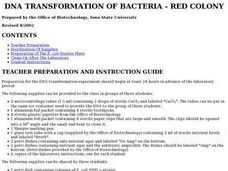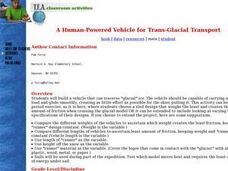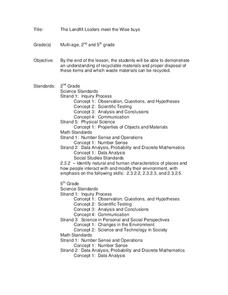Curated OER
Calorimetry
Learners construct a calorimeter. In this calorimetry lesson, students solve problems associated with calorimetry by constructing a calorimeter with a pop can.
Curated OER
DNA Transformation of Bacteria - Red Colony
Students perform experiments with bacteria. They discover that genes can be transferred from one bacteria to another on the plasmid by a transformation. Over a two day period, students follow detailed instructions in order to observe...
Curated OER
Red, White, and Blue
Students explore the types of chemical reactions that can be made with household products. Through various inquires, students work to perform chemical reactions using common household substances and cleaners.
Curated OER
A Hair Raising Experience
Middle schoolers rotate through various lab stations in groups as they experiment with the concepts of conduction, induction and friction. They use a generator, aluminum pie pans, paper, plastic, styrofoam and other materials to complete...
Curated OER
The Magic School Bus Out of this World
Students explore the craters that objects of different sizes and weights make. They use marbles, Ping-Pong balls, and aluminum-foil balls for this experiment. They investigate what would happen if they drop objects that aren't round.
Curated OER
It's Hot
Third graders examine the effect of sunlight on the earth. Individually, they pick an article of clothing out of a bag and sort themselves based on the color of the shirt and whether it should be worn on a cold or a hot day. To end the...
Curated OER
A Human-Powered Vehicle for Trans-Glacial Transport
Students practice problem solving skills and experimental design. They build a vehicle that can traverse "glacial" ice capable of carrying a specific load and glide smoothly, creating as little effort as possible for the skier pulling...
Curated OER
Magneto-hydrodynamic Drives
Students examine how electric and magnetic fields can be used to force water out of a chamber to move a vehicle forward.
Curated OER
Ozone Pollution: Smog Alert
Learners simulate the development of smog. They discover how it forms naturally in nature. They read news articles about the ozone and pollution. They discuss what they can do to lower the pollution they generate.
Curated OER
Floating
First graders discuss with the teacher if everything will float in water. They observe a marble and determine whether it will float making predictions as a class. After observing the results, they discover that liquids exert an upward...
Curated OER
Scouting for Circuits
Fifth graders investigate electricity and how it used in a circuit to be useful energy. They also use this investigation in order to understand how energy can change forms and still be considered useful if put into the right form.
Curated OER
Polarized Light
Students examine polarized light and that it can be done through reflection. In this reflection lesson students develop a model that accounts for differences in light behavior.
Curated OER
Save the Earth: It's Everyone's Home
Students explore how recycling helps save trees and protect the environment. For this environmental concern lesson, students color a handout of animals that live in forests. Students discuss how recycling paper can save trees and set up...
Curated OER
Wetlands/Watershed Model
Students make a model that will demonstrate the flow of surface water across the land in Texas and how materials that originate many miles away can end up in the wetland along the coast.
Curated OER
ESOL Environment and the World
Students examine a recyling bin and the many different items that can be recycled. They practice loading the recyclie bin and using the correct vocabulary to explain each item.
Curated OER
Temperature Control - South African Roofing Materials
Students explore how different roofing materials can have an impact on the temperature inside a house through box houses. They compare/contrast different materials in Wisconsin and South Africa. In groups, they build a box house (shoe...
Curated OER
Blowing in the Wind
Students identify and interpret maps, graphs, charts, tables and political cartoons. Students identify what a compass rose is and review its meaning in relation to standard directions. Students design their own weathervanes. Students...
Beyond Benign
Packed Up Properties
Determine physical properties of potential packaging materials. Continuing from previous lessons in the series, the resource asks groups to identify physical properties of the substances. They test for conductivity, solubility, water...
Chymist
Landfills and Recycling
Examine the nature of landfills through experimentation. Scholars build miniature landfills and monitor changes over a six-week period. Observations allow individuals to draw conclusions about the different types of trash and their...
IMAX
Hubble
Explore what it takes to service the Hubble telescope. In the set of three activities, groups investigate several aspects of the Hubble telescope, including robotic arms used during repairs, spacesuits, and extravehicular activity (EVA)...
SeaWorld
Sharks
Youngsters explore their sense of smell by working in pairs. One child is blindfolded, while the other holds things for him to smell. They switch after a while. All of this leads up to learning about the amazing ability sharks have to...
Curated OER
Pollution
Young ecologists investigate some of the many ways that human activities adversely affect the environment. After identifying the main types of pollution (air, water, soil), 3rd graders fill in a Venn Diagram by pasting cut-out pictures...
Curated OER
The Landfill Loafers Meet the Wise Buys
Students discover recyclable materials and the proper disposal of those items through Internet research. Working in groups of four, they search the Internet for uses of recyclable materials. After research is complete, they participate...
Curated OER
Fourth Grade Science
In this science worksheet, 4th graders answer multiple choice questions about coastlines, electric cars, the food chain, and more. Students complete 25 questions.























